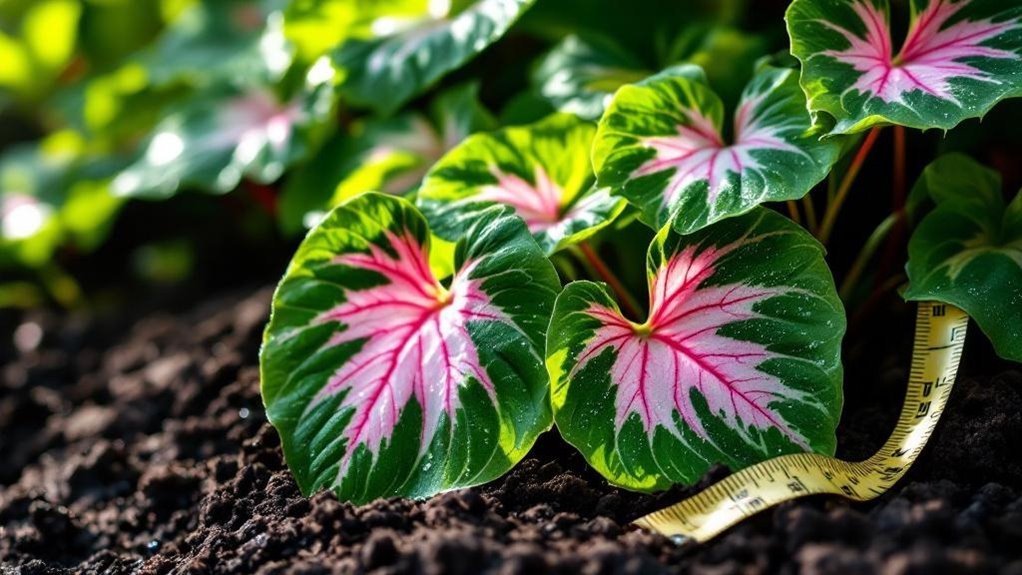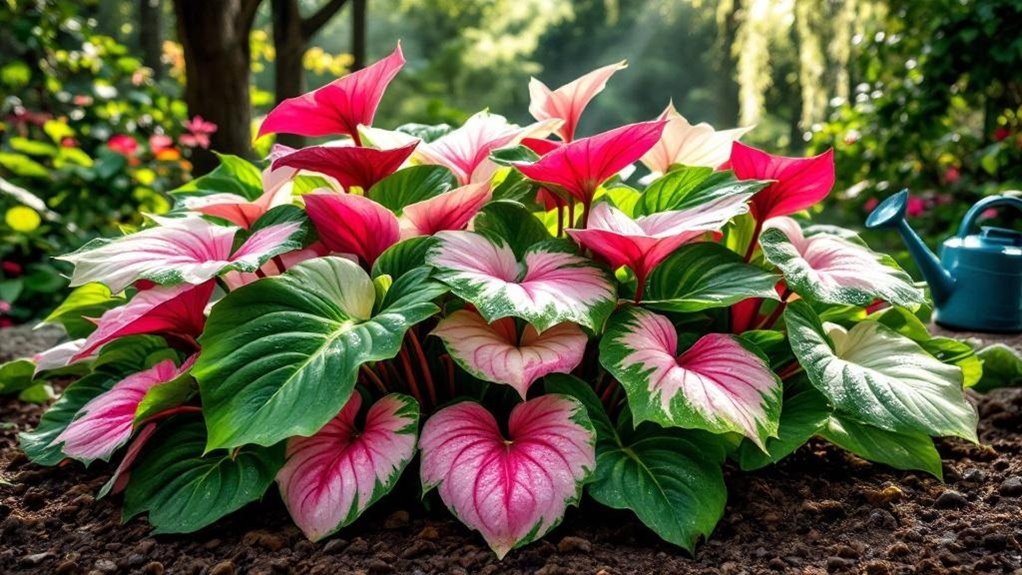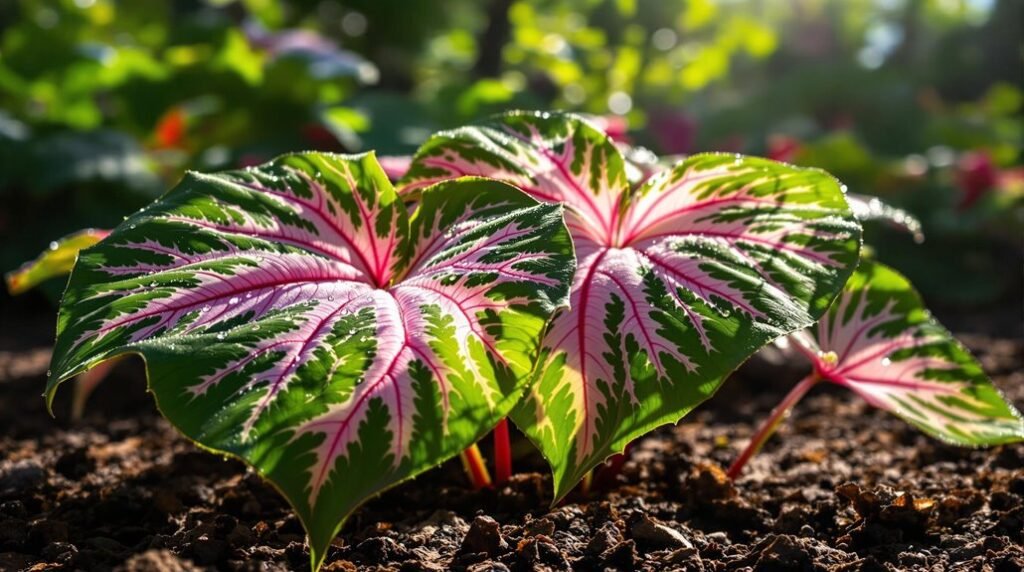It’s funny how you might stumble upon caladiums just as you’re searching for the perfect plants to brighten your shady garden spots. These colorful, heart-shaped leaves thrive where many plants struggle, offering a splash of vibrancy in partial shade. But getting them to flourish takes more than just planting a tuber. If you want to understand what makes caladiums thrive and avoid common pitfalls, there are a few key details you’ll want to know.
Caladium Plant Attributes and Varieties
Caladiums, often called angel wings or elephant ears, boast heart-shaped leaves that range from 6 to 12 inches, adding lush greenery to your shade garden.
These tropical plants come mainly in two leaf types: Fancy Leaf caladiums, which thrive in shade, and Strap Leaf varieties, more sun-tolerant.
Caladiums offer two main leaf types: shade-loving Fancy Leaf and sun-tolerant Strap Leaf varieties.
Fancy Leaf caladiums stand out with their colorful leaves, featuring striking patterns and hues like reds, pinks, and whites—perfect for brightening shady spots.
Popular varieties include Fire Chief, Carolyn Whorton, and Moonlight, each offering unique visual appeal.
To keep your caladiums vibrant, plant them in well-drained soil rich in organic matter.
Their tropical nature means they flourish best in dappled light, making them ideal for adding lush, colorful leaves to any shade garden setting.
Ideal Growing Conditions for Caladiums
Although these vibrant plants can tolerate some sun, you’ll get the best results by providing them with partial shade—around 4 to 6 hours of filtered sunlight daily.
Caladiums thrive in these light conditions, avoiding harsh sun that can scorch their delicate leaves. When you plant caladiums, choose well-drained, slightly acidic soil rich in organic matter to support healthy tuber growth and prevent rot.
Keep the soil consistently moist but never waterlogged, especially early in the growing season. Ideal growing conditions include air temperatures above 60°F and soil temperatures of 65°F or warmer.
While some caladium varieties handle more sun if well-irrigated, most prefer shade or partial shade to flourish. By meeting these growing conditions, you’ll guarantee your caladium plants stay vibrant and healthy.
When and How to Plant Caladium Tubers

When soil temperatures reach at least 65°F and the air stays consistently above 60°F, you can plant caladium tubers to guarantee they grow vigorously. Typically, this happens from mid-March to early April.
To plant caladiums, choose a part shade location and plant them directly into moist soil. Dig holes about 1.5 to 2 inches deep, placing the knobby side of each tuber facing upward. Space #1 tubers 8 to 10 inches apart to allow room for growth.
Keep the soil consistently moist but avoid waterlogging to prevent rot. Once sprouts reach several inches tall, apply mulch to retain moisture and reduce weeds.
Light and Sun Exposure Requirements
If you want your caladiums to flourish, providing them with the right amount of light is essential.
Caladiums thrive best in part shade, needing about 4-6 hours of sun exposure daily. Some varieties tolerate full sun if you keep them well-watered, but too much direct sunlight can scorch their foliage, causing “melting.” When that happens, move your plants to a shaded spot immediately.
Fancy Leaf types prefer more shade, while Strap Leaf varieties handle brighter light better.
Watch your caladiums’ bright leaves closely—dull colors mean they need more light, while overly bright or faded foliage suggests too much sun exposure.
The ideal location offers bright, dappled light, which encourages lush growth and vibrant leaves, making your caladiums a stunning shade garden highlight.
Watering and Soil Preferences

To keep your caladiums healthy, provide them with well-drained, slightly acidic soil rich in organic matter to prevent tuber rot.
Water your caladiums regularly to maintain consistent moisture without saturating the soil. Since these shade-loving plants prefer moist conditions, adjust watering based on how much sunlight they receive.
Remember these key points for watering and soil:
- Water early in the morning to maintain moisture and protect leaves from sunburn.
- Confirm soil temperature is at least 65°F before planting caladium tubers in the ground.
- Mulch around your plants to help retain soil moisture, especially in brighter spots.
Fertilizing Caladiums for Optimal Growth
Although caladiums don’t require heavy feeding, applying a high-nitrogen fertilizer every six weeks during the growing season helps you encourage lush, vibrant foliage.
You can also use a water-soluble fertilizer monthly for ideal nutrient delivery. Fertilization plays a supportive role in caladium growth, so continuous-release plant food can maintain steady development without overwhelming the plant.
To avoid nutrient deficiencies, consider soil testing to tailor your fertilization plan precisely. Be cautious not to over-fertilize, as excessive nutrients may cause leaf damage and hinder your caladiums’ health.
Managing Pests and Diseases
While caladiums are generally resistant to pests and diseases, you should stay vigilant, especially since overwatering or too much sun can cause issues like tuber rot and leaf damage.
Keep an eye out for yellowing leaves, which could signal a nutrient deficiency or improper watering.
To manage pests and diseases effectively:
- Check regularly for aphids and spider mites, which thrive in low humidity.
- Confirm your caladiums grow in well-drained soil to prevent fungal diseases caused by excess moisture.
- Adjust location if leaves start “melting” from too much sun to reduce plant stress.
Overwintering and Tubers Storage Techniques
Since caladiums enter dormancy between late September and October, you’ll want to lift the tubers before the first frost hits to guarantee they survive the winter.
Carefully dig up the caladium bulbs, then air dry them in a warm spot for a few days to prevent rot.
Once dry, use proper storage techniques by placing the tubers in a brown paper bag filled with dry peat moss.
Roll down the bag’s top and keep it in a warm, dry location like a garage or basement.
This method guarantees successful overwintering by maintaining tuber viability.
Propagation and Maintenance Practices
If you want to successfully propagate caladiums, start by dividing larger tubers in early spring, making sure each section has at least one eye to encourage new growth.
Proper maintenance is key to keeping Caladiums vibrant and healthy. Focus on consistent watering to keep soil slightly moist without causing root rot. Remove damaged foliage and any flower spathes to highlight the plant’s colorful leaves.
Keep soil moist and trim damaged leaves to maintain vibrant, healthy Caladiums.
Use a high-nitrogen fertilizer every six weeks during the growing season to support lush foliage. When Caladiums go dormant, stop watering and let the foliage die back naturally to prepare tubers for storage.
- Divide tubers early spring for effective propagation
- Water moderately and remove dead foliage regularly
- Fertilize every six weeks during active growth for best results
Frequently Asked Questions
Can Caladiums Grow in Full Shade?
You can grow caladiums in full shade, but they’ll develop smaller leaves and less vibrant colors. They thrive best with 4-6 hours of indirect sunlight, so giving them some filtered light helps keep them healthy and bright.
What Is the Secret to Growing Caladiums?
You want the secret? Just whisper sweet nothings to your caladiums, then plant bulbs 2 inches deep in well-drained soil, give them partial shade, keep soil moist, and avoid overwatering. Easy, right?
Do Caladiums Grow Well Under Trees?
Yes, caladiums grow well under trees since they love shade and filtered sunlight. Just make sure you keep the soil well-drained and moist, and watch their leaves for signs they need more light or water.
How Many Hours of Sun Do Caladiums Need?
Wondering how much sun caladiums need? They thrive best with 4-6 hours of filtered sunlight daily. Too much direct sun can scorch their leaves, so you’ll want to keep them mostly in part shade.
Final Thoughts
You might think growing caladiums is complicated, but really, all they want is some shade, a bit of water, and a warm spot to call home. If you can manage that, you’re halfway there—no green thumb required. Just remember, these colorful beauties thrive when you give them a little attention and patience, proving that sometimes, the simplest plants demand just a tiny bit of effort to shine bright in your garden.
